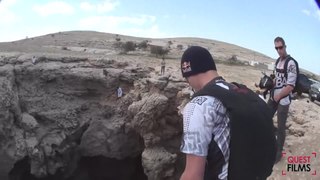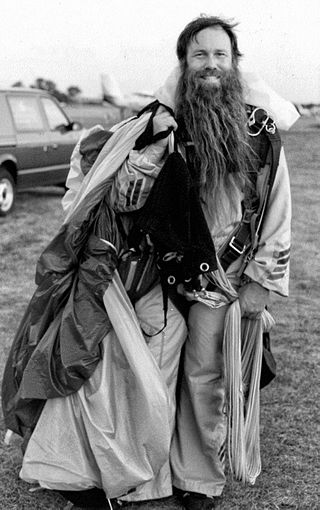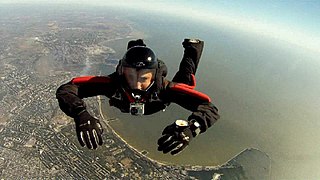
BASE jumping is the recreational sport of jumping from fixed objects, using a parachute to descend safely to the ground. "BASE" is an acronym that stands for four categories of fixed objects from which one can jump: buildings, antennæ, spans (bridges), and earth (cliffs). Participants exit from a fixed object such as a cliff, and after an optional freefall delay, deploy a parachute to slow their descent and land. A popular form of BASE jumping is wingsuit BASE jumping.

An altimeter or an altitude meter is an instrument used to measure the altitude of an object above a fixed level. The measurement of altitude is called altimetry, which is related to the term bathymetry, the measurement of depth under water. The most common unit for altimeter calibration worldwide is hectopascals (hPa), except for North America and Japan where inches of mercury (inHg) are used. To obtain an accurate altitude reading in either feet or meters, the local barometric pressure must be calibrated correctly using the barometric formula.

A parachute is a device used to slow the motion of an object through an atmosphere by creating drag or, in a ram-air parachute, aerodynamic lift. A major application is to support people, for recreation or as a safety device for aviators, who can exit from an aircraft at height and descend safely to earth.

High-altitude military parachuting, or military free fall (MFF), is a method of delivering military personnel, military equipment, and other military supplies from a transport aircraft at a high altitude via free-fall parachute insertion. Two techniques are used: HALO and HAHO.

Wingsuit flying is the sport of skydiving using a webbing-sleeved jumpsuit called a wingsuit to add webbed area to the diver's body and generate increased lift, which allows extended air time by gliding flight rather than just free falling. The modern wingsuit, first developed in the late 1990s, uses a pair of fabric membranes stretched flat between the arms and flanks/thighs to imitate an airfoil, and often also between the legs to function as a tail and allow some aerial steering.

A drogue parachute is a parachute designed for deployment from a rapidly-moving object. It can be used for various purposes, such as to decrease speed, to provide control and stability, or as a pilot parachute to deploy a larger parachute. Vehicles that have used drogue parachutes include multi-stage parachutes, aircraft, and spacecraft recovery systems.

CYPRES is an acronym for Cybernetic Parachute Release System. It refers to a specific make and model of an automatic activation device (AAD), a device that automatically activates a parachute under certain circumstances. A CYPRES is designed to activate the reserve parachute at a preset altitude if the rate of descent is over a certain threshold. The manufacturer of the CYPRES is Airtec.

Bill Booth is an American engineer, inventor, and entrepreneur in the skydiving equipment manufacturing industry. His invention of the 3-ring release safety device has enhanced skydiving safety. He founded the companies United Parachute Technologies and Complete Parachute Solutions, which had 150 employees as of 2015.

A slider is a small rectangular piece of fabric with a grommet near each corner used to control the deployment of a "ram-air" parachute. Also called a "reefing device." A ram-air parachute has a tendency to open very rapidly. At high velocities, the opening shock from a rapid deployment can cause damage to the canopy or injury to the jumper. The slider was developed as a way of mitigating this. During deployment, the slider slides down from the canopy to the risers. Air resistance slows its descent. The slider holds the lines together, which slows the parachute inflation. The slider also deflects some of the rising air column away from the center of the canopy as it inflates. This also helps moderate the speed of opening. This invention solved the rapid deployment problem with ram-air designs. Sliders also reduce the chance of the lines twisting to cause a malfunction.

A malfunction is a partial or total failure of a parachuting device to operate as intended. Malfunctions may require a skydiver to cut away their main parachute and deploy the reserve parachute.

A static line is a fixed cord attached to a large, stable object. It is used to open parachutes automatically for paratroopers and novice parachutists.

A pilot chute is a small auxiliary parachute used to deploy the main or reserve parachute. The pilot chute is connected by a bridle to the deployment bag containing the parachute. Pilot chutes are a critical component of all modern skydiving and BASE jumping gear. Pilot chutes are also used as a component of spacecraft such as NASA's Orion.

Tandem skydiving or tandem parachuting refers to a type of skydiving where a student skydiver is connected to an instructor via a harness. The instructor guides the student through the whole jump from exit through freefall, piloting the canopy, and landing. The student needs only minimal instruction before making a tandem jump with the instructor. In the United States most skydiving centers and clubs require that you be 18 years or older to skydive whereas in other countries the minimum age can be lower or higher. This is one of three commonly used training methods for beginning skydivers; the others being Static line, Instructor-assisted deployment (IAD), and Accelerated freefall (AFF) (k).
Cut-away is a skydiving term referring to disconnecting the main parachute from the harness-container in case of a malfunction in preparation for opening the reserve parachute. The 3-ring release system on parachutes allows a rapid cut-away in the event of an emergency.

A reserve static line, occasionally called a Stevens Lanyard, is a device that automatically opens the reserve parachute container when the main parachute is cut-away. The RSL is a lanyard connecting one or both of the main parachute risers to the reserve ripcord.

Accelerated freefall (AFF) is a method of skydiving training. This method of skydiving training is called "accelerated" because the progression is the fastest way to experience solo freefall, normally from 10,000 to 15,000 feet above ground level (AGL). In static line progression, more jumps are required to experience freefall, but the jumps are less expensive for the student as one instructor can dispatch multiple students per load and students are initially dispatched from lower altitudes. Under accelerated freefall, one or sometimes two instructors are dedicated just to one student.
James Franklin Oldham, better known as Jim O'Brien, was an American newscaster.

Parachuting, including also skydiving, is a method of transiting from a high point in the atmosphere to the surface of Earth with the aid of gravity, involving the control of speed during the descent using a parachute or parachutes.
Parachute School of Toronto is a Canadian Sport Parachuting Association affiliated parachuting centre and skydiving drop zone operating from the Seagrave/North Port Aerodrome near Scugog.
A Main-Assisted Reserve Deployment (MARD) system is a skydiving safety device for parachute systems. While there are many variations, the operation and intended outcome for each is the same: open the reserve parachute container and extract the reserve parachute's deployment bag using the jettisoned main canopy. A MARD builds upon how a reserve static line (RSL) safety device works and in most circumstances, MARDs incorporate an RSL.
















